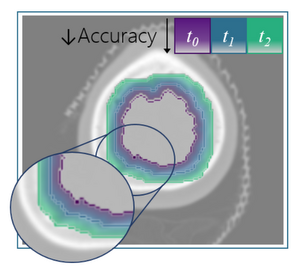Information
- Publication Type: Conference Paper
- Workgroup(s)/Project(s):
- Date: September 2021
- Publisher: Eurographics Association
- Lecturer: Caroline Magg
- Event: EG VCBM 2021
- DOI: 10.2312/vcbm.20211343
- Call for Papers: Call for Paper
- Booktitle: Eurographics Workshop on Visual Computing for Biology and Medicine (VCBM2021).
- Pages: 5
- Pages: 31 – 35
Abstract
Pediatric brain tumor radiotherapy research is investigating how radiation influences the development and function of a pa- tient’s brain. To better understand how brain growth is affected by the treatment, the brain structures of the patient need to be explored and analyzed pre- and post-treatment. In this way, anatomical changes are observed over a long period, and are as- sessed as potential early markers of cognitive or functional damage. In this early work, we propose an automated approach for the visual assessment of the growth prediction of brain structures in pediatric brain tumor radiotherapy patients. Our approach reduces the need for re-segmentation, and the time required for it. We employ as a basis pre-treatment Computed Tomography (CT) scans with manual delineations (i.e., segmentation masks) of specific brain structures of interest. These pre-treatment masks are used as initialization, to predict the corresponding masks on multiple post-treatment follow-up Magnetic Resonance (MR) images, using an active contour model approach. For the accuracy quantification of the automatically predicted post- treatment masks, a support vector regressor (SVR) with features related to geometry, intensity, and gradients is trained on the pre-treatment data. Finally, a distance transform is employed to calculate the distances between pre- and post-treatment data and to visualize the predicted growth of a brain structure, along with its respective accuracy. Although segmentations of larger structures are more accurately predicted, the growth behavior of all structures is learned correctly, as indicated by the SVR results. This suggests that our pipeline is a positive initial step for the visual assessment of brain structure growth predictioAdditional Files and Images
Weblinks
- Entry in reposiTUm (TU Wien Publication Database)
- Entry in the publication database of TU-Wien
- DOI: 10.2312/vcbm.20211343
BibTeX
@inproceedings{magg2021,
title = "Visual Assessment of Growth Prediction in Brain Structures
after Pediatric Radiotherapy",
author = "Caroline Magg and Laura Toussaint and Ludvig Paul Muren and
Danny Indelicato and Renata Raidou",
year = "2021",
abstract = "Pediatric brain tumor radiotherapy research is investigating
how radiation influences the development and function of a
pa- tient’s brain. To better understand how brain growth
is affected by the treatment, the brain structures of the
patient need to be explored and analyzed pre- and
post-treatment. In this way, anatomical changes are observed
over a long period, and are as- sessed as potential early
markers of cognitive or functional damage. In this early
work, we propose an automated approach for the visual
assessment of the growth prediction of brain structures in
pediatric brain tumor radiotherapy patients. Our approach
reduces the need for re-segmentation, and the time required
for it. We employ as a basis pre-treatment Computed
Tomography (CT) scans with manual delineations (i.e.,
segmentation masks) of specific brain structures of
interest. These pre-treatment masks are used as
initialization, to predict the corresponding masks on
multiple post-treatment follow-up Magnetic Resonance (MR)
images, using an active contour model approach. For the
accuracy quantification of the automatically predicted post-
treatment masks, a support vector regressor (SVR) with
features related to geometry, intensity, and gradients is
trained on the pre-treatment data. Finally, a distance
transform is employed to calculate the distances between
pre- and post-treatment data and to visualize the predicted
growth of a brain structure, along with its respective
accuracy. Although segmentations of larger structures are
more accurately predicted, the growth behavior of all
structures is learned correctly, as indicated by the SVR
results. This suggests that our pipeline is a positive
initial step for the visual assessment of brain structure
growth predictio",
month = sep,
publisher = "Eurographics Association",
event = "EG VCBM 2021",
doi = "10.2312/vcbm.20211343",
booktitle = "Eurographics Workshop on Visual Computing for Biology and
Medicine (VCBM2021).",
pages = "5",
pages = "31--35",
URL = "https://www.cg.tuwien.ac.at/research/publications/2021/magg2021/",
}


